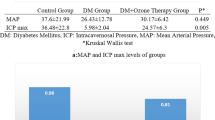Abstract
The aim of the study is to determine and to compare the oxidative and antioxidative status of penile corpus cavernosum and peripheral venous blood. A total of 28 adult healthy males were included in the study. Whole blood was simultaneously withdrawn from penile corpus cavernosum and the cubital vein and their plasma separated. Total antioxidant capacity (TAC), vitamin C, total protein, albumin, uric acid, bilirubin and total peroxide (TP) levels of both plasma samples were measured and compared. While TAC, total protein, albumin, bilirubin and uric acid levels were higher, vitamin C levels were lower in cavernosal blood than that of peripheral blood. On the other hand, TP level was found to be higher in penile blood samples than that of peripheral blood. We thought that the normal erectile process of the penile cavernosal body leads to increased production of oxidants as in the mechanism of ischaemia–reperfusion; however, the increase of TAC can prevent development of oxidative injury.
This is a preview of subscription content, access via your institution
Access options
Subscribe to this journal
Receive 8 print issues and online access
$259.00 per year
only $32.38 per issue
Buy this article
- Purchase on Springer Link
- Instant access to full article PDF
Prices may be subject to local taxes which are calculated during checkout
Similar content being viewed by others
References
Erel O . A novel automated method to measure total antioxidant response against potent free radical reactions. Clin Biochem 2004; 37: 112–119.
Jones RW et al. Oxygen free radicals and the penis. Expert Opin Pharmacother 2002; 3: 889–897.
Becker AJ et al. Plasma levels of angiotensin II during different penile conditions in the cavernous and systemic blood of healthy men and patients with erectile dysfunction. Urology 2001; 58: 805–810.
Hamed EA, Meki AR, Gaafar AA, Hamed SA . Role of some vasoactive mediators in patients with erectile dysfunction: their relationship with angiotensin-converting enzyme and growth hormone. Int J Impot Res 2003; 15: 418–425.
Fernandez-Arjona M et al. Antioxidative state and lipid peroxidation in erectile dysfunction: preliminary study. Arch Esp Urol 2001; 54: 361–366.
Bivalacqua TJ et al. Gene transfer of extracellular SOD to the penis reduces O2−• and improves erectile function in aged rats. Am J Physiol Heart Circ Physiol 2003; 284: 1408–1421.
Rajasekaran M, Hellstrom WJ, Sikka SC . Nitric oxide induces oxidative stress and mediates cytotoxicity to human cavernosal cells in culture. J Androl 2001; 22: 34–39.
Munarriz R et al. Reperfusion of ischemic corporal tissue: physiologic and biochemical changes in an animal model of ischemic priapism. Urology 2003; 62: 760–764.
Gonzalez-Cadavid NF et al. Gene expression in Peyronie's disease. Int J Impot Res 2002; 14: 361–374.
Benzie IF, Strain JJ . The ferric reducing ability of plasma (FRAP) as a measure of ‘antioxidant power’: the FRAP assay. Anal Biochem 1996; 239: 70–76.
Benzie IF, Strain JJ . Ferric reducing/antioxidant power assay: direct measure of total antioxidant activity of biological fluids and modified version for simultaneous measurement of total antioxidant power and ascorbic acid concentration. Methods Enzymol 1999; 299: 15–27.
Cao G, Prior RL . Comparison of different analytical methods for assessing total antioxidant capacity of human serum. Clin Chem 1998; 44: 1309–1315.
Miyazawa T . Determination of phospholipid hydroperoxides in human blood plasma by a chemiluminescence-HPLC assay. Free Radic Biol Med 1989; 7: 209–217.
Harma M, Harma M, Erel O . Increased oxidative stress in patients with hydatidiform mole. Swiss Med Wkly 2003; 133: 563–566.
Lue TF . Male sexual dysfunction. In: Tanagho EA, McAninch JW (eds). Smith's General Urology. Lange Medical Books/McGrav-Hill: San Francisco, 2000 pp 788–810.
Burnett AL . Nitric oxide in the penis: physiology and pathology. J Urol 1997; 157: 320–324.
Cartledge J, Minhas S, Eardley I . The role of nitric oxide in penile erection. Expert Opin Pharmacother 2001; 2: 95–107.
Saenz de Tejada I . Molecular mechanisms for the regulation of penile smooth muscle contractility. Int J Impot Res 2002; 14 (Suppl 1): 6–10.
Gutteridge JM . Lipid peroxidation and antioxidants as biomarkers of tissue damage. Clin Chem 1995; 41: 1819–1828.
Brody S . High-dose ascorbic acid increases intercourse frequency and improves mood: a randomized controlled clinical trial. Biol Psychiatry 2002; 52: 371–374.
Erel O . A novel automated direct measurement method for total antioxidant capacity using a new generation, more stable ABTS radical cation. Clin Biochem 2004; 37: 277–285.
Author information
Authors and Affiliations
Corresponding author
Rights and permissions
About this article
Cite this article
Yeni, E., Gulum, M., Selek, S. et al. Comparison of oxidative/antioxidative status of penile corpus cavernosum blood and peripheral venous blood. Int J Impot Res 17, 19–22 (2005). https://doi.org/10.1038/sj.ijir.3901262
Received:
Revised:
Accepted:
Published:
Issue Date:
DOI: https://doi.org/10.1038/sj.ijir.3901262
Keywords
This article is cited by
-
Total antioxidant capacity and total oxidant status of synovial fluids in patients with temporomandibular joint pain and dysfunction
Clinical Oral Investigations (2012)
-
Endothelial dysfunction in diabetic erectile dysfunction
International Journal of Impotence Research (2007)
-
Increased oxidative stress and its relation with collagen metabolism in knee osteoarthritis
Rheumatology International (2007)
-
Increased oxidative stress in infants exposed to passive smoking
European Journal of Pediatrics (2005)



